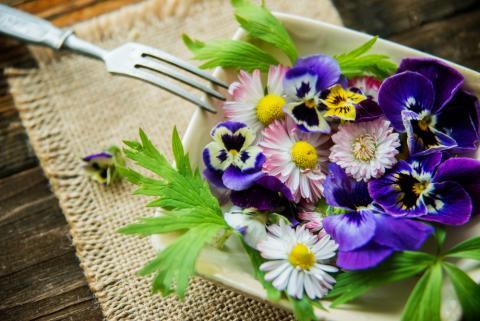
We eat the fruits, the leaves, the roots, and even the bark of many plants and trees. But why leave the flowers? Here’s a list of flowers you can eat and use in recipes big or small.
Basically, any flower that is not poisonous and tastes pleasant automatically becomes an edible flower. If it is pleasing to look at, then it is often added into cakes and confectionary, or even sugared for decoration. But before you go grazing in your garden, do take care, for some flowers have an arsenal of the nasties that can give more than just a lingering aftertaste. Many flowers have poisons or toxins in them that can earn you a trip to the doctor—so eat flowers with care.
Before You Pluck The Blooms
- Let the flowers remain pretty as a picture in the garden if you have allergies or even asthma—the pollen in the flowers can aggravate your condition if ingested.
- Grow your flowers organically—this way they are safe from pesticide and insecticide residue.
- Make sure the flowers you have plucked to eat belong to an edible species—some flowers are lookalikes of edible flowers and can end up giving you a reaction instead.
- Pluck your flowers early morning after the dew has evaporated or in the late afternoon when the weather has cooled down a bit. You’ll get the freshest crop this way.
- Pick your flower crop at its peak—not when the flower is only half open or beginning to wilt. The beautiful and brightest blooms will not only look gorgeous on your dishes but also taste the best. Edible flowers are their best at their freshest.
Spring & Summer Flowers You Can Eat
Annual flowers are mostly spring or summer flowers—they bloom in spring and summer and then they die. The next year, if you want them again, you have to replant them. Here are some spring and summer flowers that are pretty easy to grow—all they need is well-aerated soil and a decent amount of sunlight, along with regular watering. Plus a few cooking ideas…
- Calendula: With longish leaves and bright flowers that come in shades of yellow, gold, or orange, the calendula flower has a tangy peppery taste. It is for this reason calendula was called pot marigold—the flowers were thrown into broth pots to add spice! Remember to remove the central part of the flower, which is bitter, and use only the petals. It can spice up a broth, a curry, or even a salad—and add some color as well.
- Marigold: Marigold is a diverse species, but not all of them have culinary uses. The African marigold has white, gold, yellow, or red flowers with a strongly pungent flavor. The Signet and the French marigold, on the other hand, have a citrus flavor. You can spice up soups with them, or even add them to rice and pasta dishes. They do impart a yellow color to the food (the reason they are called a poor man’s saffron).
- Nasturtium: Pretty flowers that wilt literally as soon as they are picked, nasturtiums come in shades of white to red and range in flavors from mildly bitter to peppery. Spice up soups with them, or make an herbed butter as well.
- Pansy: Pansies really light up a garden with beautiful blooms in violet, white, pink, yellow—and they have a sweet flavor as well so you can add them to your cakes, cookies, and confectionary.
- Petunia: Petunias come in a wide variety of colors as well—and they have mild, almost bland flavor. Cooking with petunias is mostly restricted to cakes and other desserts.
- Salvia: Salvia or sage has a mild and musky flavor that goes wonderfully well in bread or stir-fries and can even be added to a pesto for a quaint flavor. Flowers may be blue, purple, white, or pink and look as pretty as they taste. Pineapple sage has the same sage-like flavors but with pineapple undertones and can be used much like salvia itself.
- Snapdragon: These quaint flowers come in a wide range of colors and their mild flavors make them an ideal salad garnish.
- Scented Geranium: They may smell like roses, but scented geraniums have fruity flavors like apple and lemon. Basically, whenever you need some tanginess, think scented geraniums. They can also make some awesomely scented sugar…Here are some more ideas.
- Squash: The squash family has yellow to orange flowers and since they have to turn into squash later, they have a mild squash flower. You can make wonderful fritters with them, dipped in tempura batter and fried. Stuffed squash flowers or even zucchini flowers are options as well.
- Sunflower: So while the seeds taste great, the flowers have quaint flavors too. The buds have a mild artichoke-like flavor while the fully unfurled petals go a tad bitter. Sautéing the buds in olive oil and a little garlic makes for a lovely side dish.
- Tuberous Begonia: There is a reason you get hummingbirds and butterflies flitting about a tuberous begonia bush—the white, pink, yellow, red, orange, or multi-colored flowers have a lovely citrus flavor. Their color and sour taste make them a cool addition to salads at many organic bars.
Hope you enjoy your flowers and do send us your recipe ideas in the comments section below…








